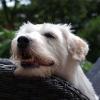Tiling from Marvelous Designer is crazy. [solved]
 AbnerK
Posts: 718
AbnerK
Posts: 718
Hi,
I've made an item of clothing and I made the materials for it. The UV Map for the clothing happened to be 2048px and the shader maps are 1024. In order for them material to look good I had to dial in the tiling to 0.05. I had this 'issue' a number of times when I've made an item of clothing and use a shader that I'd bought in the shop that was inteded to be used set to 5 tiles or so yet I've had to dial it dow to 0.05 inorder to see the detail. This is the complete opposite to what I'm used to. If I dial in the torso of G8M to 0.05 themap is 'zoomed in' which is what I expect so why is it working in the opposite way for the clothing?
If it helps I made the clothing in Marvelous Designer. Does MD do something weird?


Comments
UVs are 0-1 - they don't have a pixel size, or even a proportion, any image will (if the tiling is one) be spread over the 0-1 range. I really don't understand what you are describing, a picture or two may help.
I know, which is why I hadn't worried about the pixel count before. I'll see if I can show what I mean tomorrow. Thanks.
When they UV mapped the item, they must have mapped it to a small area of a large singular image. Thus, to get tiling, you need to shrink that large singular image to become "tiled", as many small divisions of that image.
Now, if they UV mapped that item to a "tiled" image, then when you replace the image, it will already be matched-up.
The only missing value that I wish they had, for UV adjustment, is "rotation". You can scale the image to become a repeating pattern or turn a repeating pattern into a singular spread, as well as offset the X and Y positions. However, you can't alter the rotation, within the program. (You can alter that in a paint program, with some crafty manipulation and the use of tiling.)
But, that is normal, for an un-tiled image, which you are trying to turn into a tiled mapping. The reason it is done that way, is simply so you can make any size image, for different quality levels, and they will all line-up, without having to adjust the UV-mapping. Unfortunately, that isn't your case.
However, since that much detail may not be seen, you could simply just reduce your image size and make that into a large tiled image. Your scale was 0.05 so, if my math is right... 1.0 / 0.05 = 20... so you need to reduce your image by 80% (so it is 20% of the size it is now), then apply them, tiled by 20x20 images, in one singular image, which was the same size as your original image that you shrunk to 20%... Now the UV-mapping will be perfect and you won't have to adjust the UV-mapping values.
EG... Your original image is 2048x2048... Shrink that to about 102x102 and then tile that image on a new image which is 20x larger... 2040x2040 which now has 20x20 tiles on it. Use that image. If you want more detail... Only shrink it to 204x204 and tile those on a 4080x4080 image.
You get the bonus of being able to make the pattern look less repeating, when you do it that way. You can paint additional distortions, manipulate the patterns and paint-on wrinkles and surface disruptions that you just can't get with solid repeating tiles alone. Plus, you don't alter the original normal-maps, or bump-maps or gloss-maps, etc...
I made it. I've asked in the Marvelous Designer forum. Having to scale a texute by a 1000 is insane.
Actually, you can. If you set both the Horizontal and Vertical Tiles values to -1, you'll get a 180 degree rotation. You'll probably have to play with the Horizontal/Vertical Offsets to get your texture centered, but it can be done.
Caveat - I've done it with text. I have no idea how it looks with faces, skin, etc.
I fixed it.
Incase anyone else has this problem. Export to Daz with these settings.